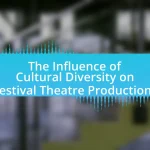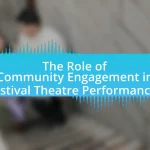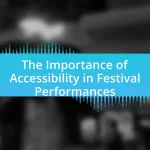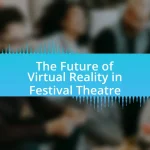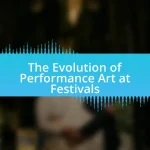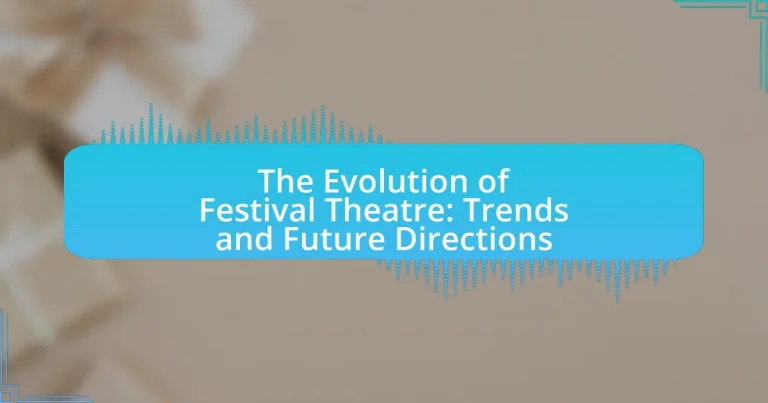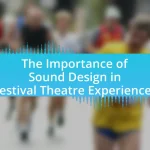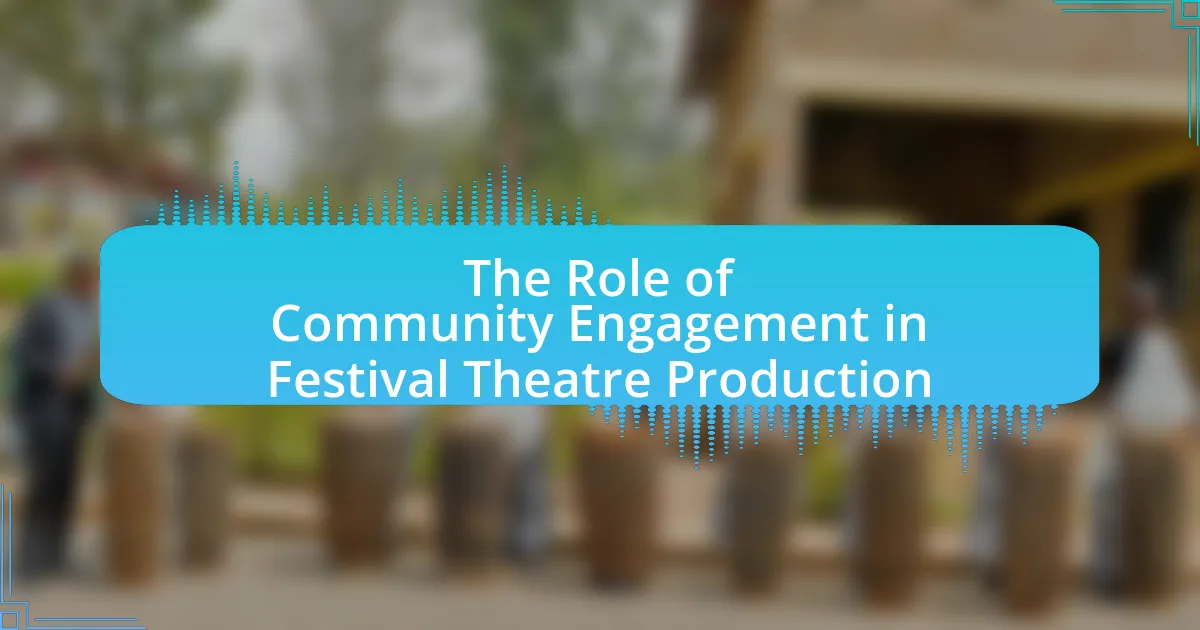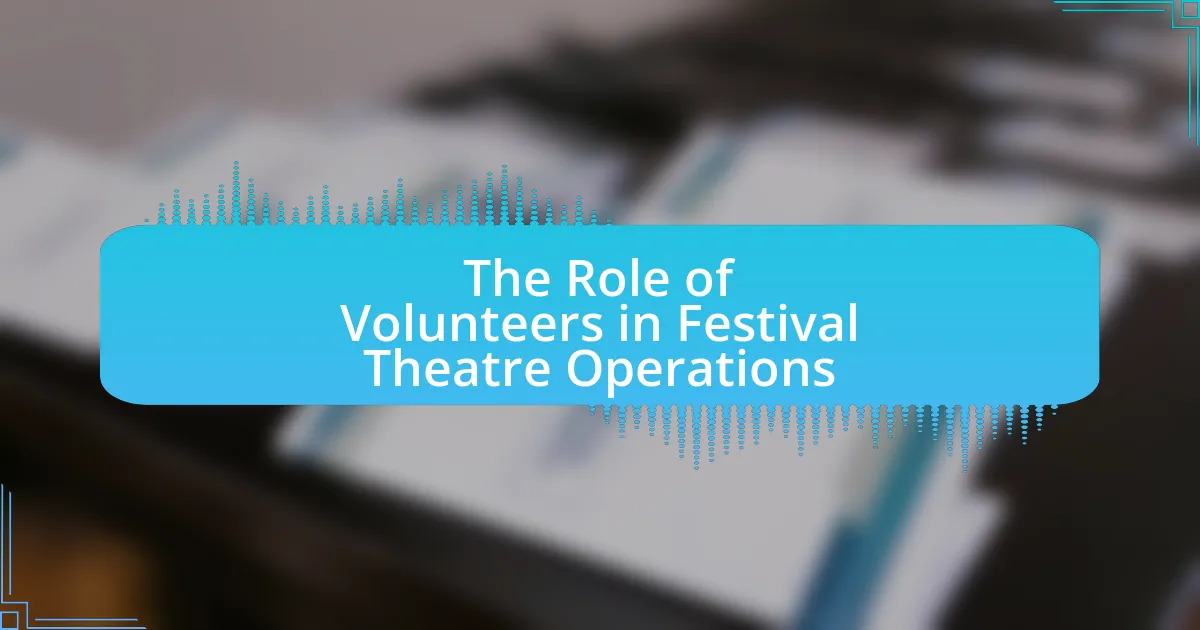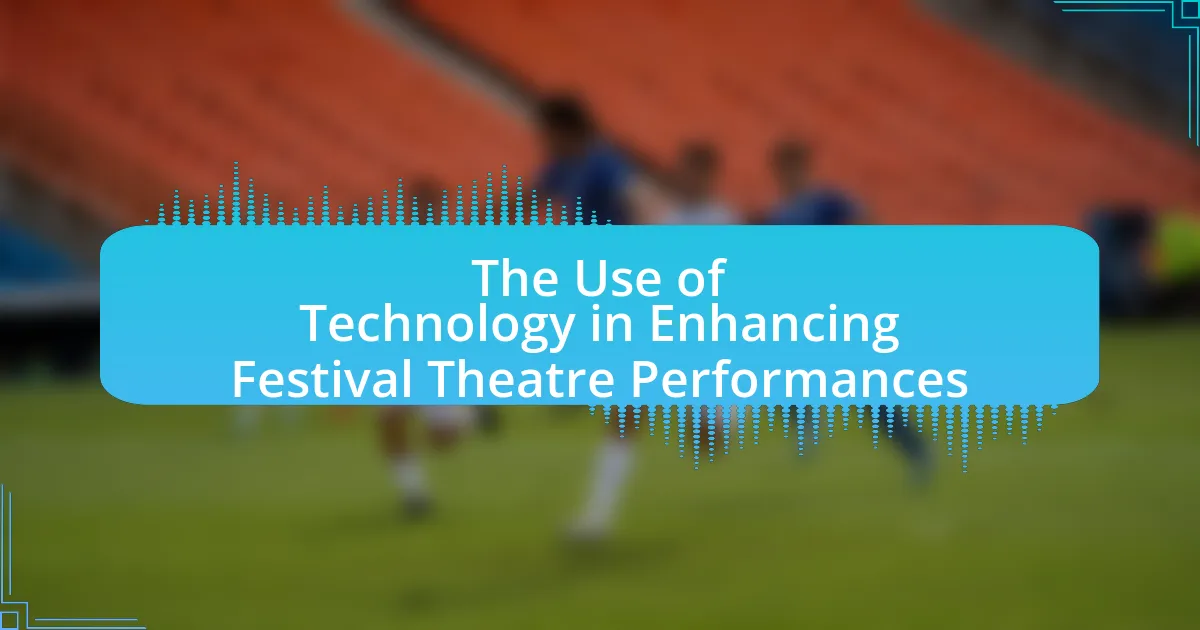The article focuses on the evolution of festival theatre, tracing its development from ancient Greek rituals to modern performances. It highlights key historical influences, such as the City Dionysia and the Renaissance, and examines how festival theatre has adapted over the decades to incorporate diverse programming, community engagement, and technological advancements. The article also discusses contemporary themes, sustainability practices, and the impact of audience demographics on festival trends. Additionally, it explores future directions for festival theatre, emphasizing the importance of innovation and inclusivity in maintaining relevance in a digital age.
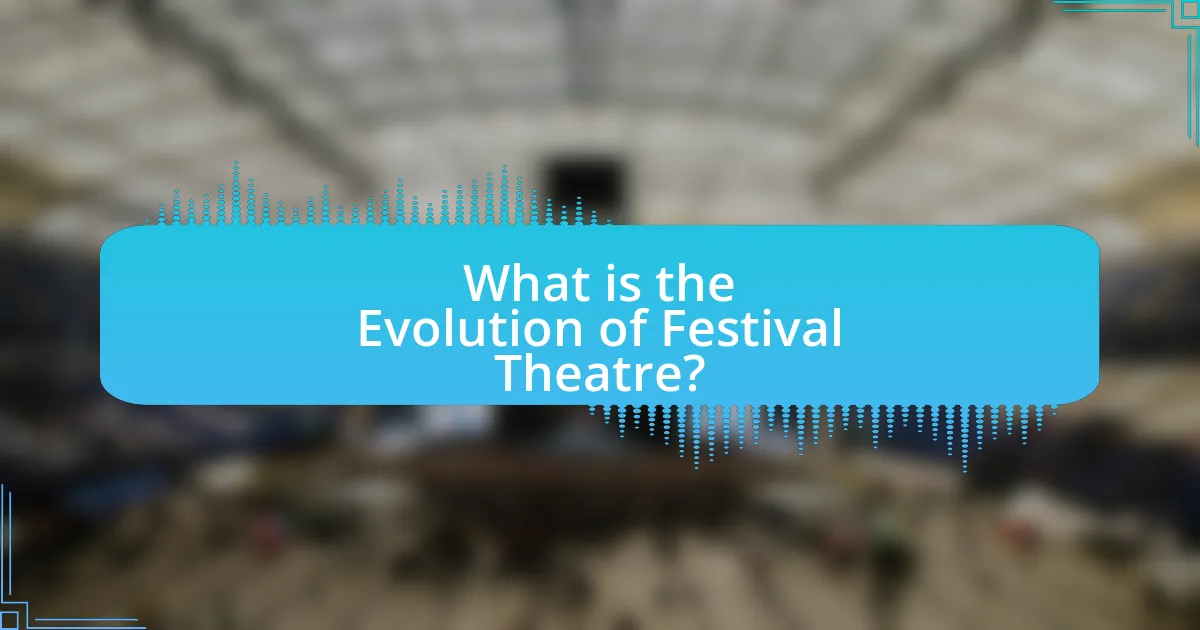
What is the Evolution of Festival Theatre?
The evolution of festival theatre encompasses its transformation from ancient rituals to contemporary performances. Initially, festival theatre emerged in ancient Greece around the 5th century BCE, where it was closely tied to religious ceremonies honoring gods, particularly during events like the Dionysia. Over centuries, this form of theatre evolved through the influence of various cultures, including the Roman Empire, which introduced more elaborate staging and diverse genres.
In the Middle Ages, festival theatre saw a resurgence with mystery plays and morality plays, often performed in public spaces to convey moral lessons. The Renaissance further advanced festival theatre, emphasizing humanism and artistic expression, leading to the establishment of formal theatre companies and festivals.
The 20th century marked a significant shift as festival theatre became more inclusive, embracing various art forms and community participation. Events like the Edinburgh Festival Fringe, established in 1947, exemplified this trend by providing a platform for diverse voices and experimental works.
Today, festival theatre continues to evolve, integrating technology and addressing contemporary social issues, reflecting the changing dynamics of society. This ongoing evolution highlights the adaptability of festival theatre as it responds to cultural shifts and audience expectations.
How has festival theatre changed over the decades?
Festival theatre has evolved significantly over the decades, transitioning from predominantly local and traditional performances to a more diverse and globalized art form. In the mid-20th century, festival theatre primarily showcased regional culture and folklore, often focusing on community engagement and local talent. By the late 20th century, festivals began to incorporate international works and contemporary themes, reflecting broader societal changes and artistic experimentation.
For instance, the Edinburgh Festival Fringe, established in 1947, initially featured local acts but has since grown to include thousands of performances from around the world, highlighting a shift towards inclusivity and diversity in programming. Additionally, advancements in technology have transformed production values, allowing for more innovative staging and multimedia integration, which has become a hallmark of modern festival theatre.
This evolution illustrates a broader trend towards globalization and artistic collaboration, making festival theatre a dynamic platform for cultural exchange and innovation.
What historical events influenced the development of festival theatre?
The development of festival theatre was significantly influenced by the ancient Greek festivals, particularly the City Dionysia, which celebrated the god Dionysus through dramatic performances. These festivals, dating back to the 6th century BCE, established a tradition of theatrical competition and communal celebration that shaped the structure and purpose of theatre. Additionally, the Renaissance revival of classical arts in Europe, marked by events such as the establishment of the Commedia dell’Arte in Italy during the 16th century, further propelled the evolution of festival theatre by introducing new forms of performance and audience engagement. The emergence of modern arts festivals in the 20th century, such as the Edinburgh Festival Fringe, also played a crucial role in expanding the scope and accessibility of theatre, fostering a diverse range of artistic expressions and cultural exchanges.
How have cultural shifts impacted festival theatre’s evolution?
Cultural shifts have significantly influenced the evolution of festival theatre by altering themes, audience engagement, and production styles. For instance, the rise of multiculturalism has led to the incorporation of diverse narratives and artistic expressions, reflecting a broader range of cultural identities. This shift is evident in festivals like the Edinburgh Festival Fringe, which showcases performances from various cultural backgrounds, promoting inclusivity and representation. Additionally, the increasing emphasis on social issues, such as climate change and social justice, has prompted festival theatre to address contemporary challenges, thereby enhancing its relevance and appeal to modern audiences. The integration of technology, driven by cultural shifts towards digital engagement, has also transformed how festivals are experienced, with virtual performances becoming more common, especially during the COVID-19 pandemic. These changes illustrate how cultural dynamics continuously shape the thematic and operational aspects of festival theatre.
What are the key characteristics of modern festival theatre?
Modern festival theatre is characterized by its emphasis on community engagement, diverse programming, and innovative use of space. Community engagement is evident as festivals often involve local artists and audiences, fostering a sense of belonging and participation. Diverse programming includes a wide range of genres and styles, from traditional performances to experimental works, reflecting contemporary societal issues and cultural diversity. Innovative use of space is highlighted by the adaptation of unconventional venues, such as parks and urban settings, which enhances accessibility and creates immersive experiences. These characteristics are supported by the growing trend of festivals like the Edinburgh Festival Fringe, which showcases thousands of performances annually, illustrating the dynamic nature of modern festival theatre.
How do contemporary themes manifest in festival theatre productions?
Contemporary themes manifest in festival theatre productions through the exploration of social issues, cultural identity, and technological integration. Productions often address current societal challenges such as climate change, racial inequality, and mental health, reflecting the audience’s lived experiences. For instance, festivals like the Edinburgh Festival Fringe showcase diverse narratives that resonate with contemporary audiences, emphasizing inclusivity and representation. Additionally, the use of multimedia and interactive elements in performances enhances engagement, allowing for a more immersive exploration of these themes. This alignment with current events and cultural dialogues ensures that festival theatre remains relevant and impactful in today’s society.
What role does technology play in modern festival theatre?
Technology plays a crucial role in modern festival theatre by enhancing audience engagement and expanding creative possibilities. Advanced sound systems, lighting design, and projection mapping allow for immersive experiences that captivate audiences, making performances more dynamic and visually appealing. For instance, the use of augmented reality in productions can create interactive elements that draw viewers into the narrative, as seen in festivals like the Edinburgh Festival Fringe, where innovative tech has transformed traditional storytelling. Additionally, digital platforms enable live streaming of performances, broadening access to global audiences and allowing for real-time interaction, which has become increasingly important in the wake of the COVID-19 pandemic. This integration of technology not only enriches the artistic expression but also adapts to contemporary viewing habits, ensuring that festival theatre remains relevant and engaging.
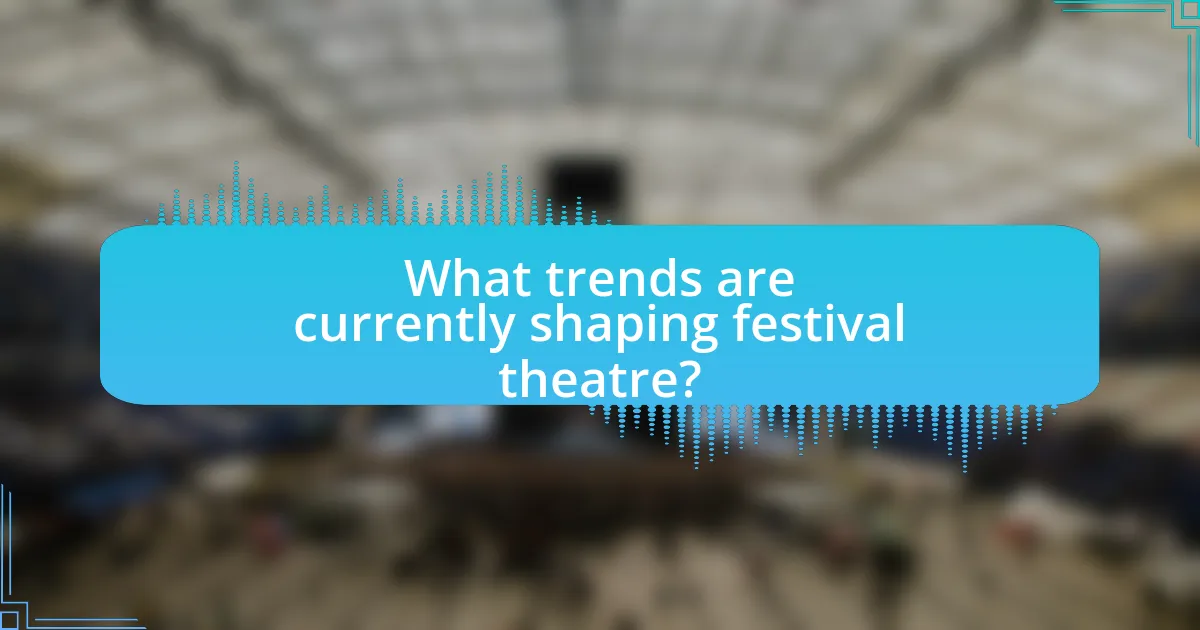
What trends are currently shaping festival theatre?
Current trends shaping festival theatre include increased diversity in programming, a focus on sustainability, and the integration of technology. Festivals are prioritizing diverse voices and stories, reflecting a broader range of cultural experiences and perspectives. For instance, many festivals now feature works by underrepresented artists, which enhances inclusivity and audience engagement. Additionally, sustainability has become a key concern, with festivals adopting eco-friendly practices such as reducing waste and utilizing renewable resources. This shift is evident in initiatives like the Edinburgh Festival Fringe’s commitment to sustainability. Furthermore, the integration of technology, including virtual reality and live streaming, is transforming how audiences experience performances, making theatre more accessible. These trends collectively indicate a significant evolution in festival theatre, responding to contemporary societal demands and technological advancements.
How are audience demographics influencing festival theatre trends?
Audience demographics are significantly influencing festival theatre trends by shaping programming choices, marketing strategies, and accessibility initiatives. For instance, festivals are increasingly curating performances that resonate with diverse age groups, cultural backgrounds, and interests, reflecting the demographic shifts in their audiences. According to a 2022 report by the National Endowment for the Arts, festivals that tailored their offerings to include multicultural performances saw a 30% increase in attendance from underrepresented communities. Additionally, younger audiences are driving the demand for interactive and immersive experiences, prompting festivals to incorporate technology and social media engagement into their events. This demographic influence is evident in the rise of festivals that prioritize sustainability and inclusivity, aligning with the values of a more socially conscious audience.
What changes in audience engagement are being observed?
Changes in audience engagement are increasingly characterized by a shift towards interactive and immersive experiences. Festivals are incorporating technology, such as augmented reality and live streaming, to enhance participation and reach wider audiences. For instance, a study by the National Endowment for the Arts in 2022 indicated that 65% of festival attendees preferred events that offered interactive elements, demonstrating a clear trend towards engagement that goes beyond passive observation. This evolution reflects a broader cultural shift where audiences seek more meaningful connections with performances and artists.
How do social media and digital platforms affect audience participation?
Social media and digital platforms significantly enhance audience participation by facilitating real-time interaction and engagement. These platforms allow audiences to share experiences, provide feedback, and connect with performers and other attendees, creating a sense of community. For instance, a study by the Pew Research Center found that 69% of adults in the U.S. use social media, which enables them to engage with content related to events, such as festival theatre, before, during, and after performances. This increased connectivity leads to higher levels of audience involvement, as individuals feel more empowered to express their opinions and share their experiences, ultimately enriching the overall festival theatre experience.
What innovative practices are emerging in festival theatre?
Innovative practices emerging in festival theatre include the integration of technology, such as augmented reality and virtual reality, to enhance audience engagement and storytelling. Festivals are increasingly utilizing immersive experiences that allow audiences to interact with performances in real-time, creating a more personalized and impactful experience. For instance, the Edinburgh Festival Fringe has seen productions that incorporate mobile apps to provide additional content and interactive elements, thereby enriching the viewer’s experience. Additionally, sustainability practices are gaining traction, with festivals adopting eco-friendly materials and reducing waste, as seen in the Green Festival Initiative, which promotes environmentally responsible practices among participating artists and venues. These trends reflect a shift towards more engaging, interactive, and sustainable approaches in festival theatre.
How are collaborations with local communities enhancing festival theatre?
Collaborations with local communities are enhancing festival theatre by fostering inclusivity and cultural relevance. These partnerships allow festival organizers to incorporate local narratives, traditions, and artistic expressions, making performances more relatable and engaging for audiences. For instance, festivals that involve community members in the creation process often see increased attendance and participation, as evidenced by the Edinburgh Festival Fringe, which reported a 20% rise in local audience engagement when community-based projects were featured. This integration not only enriches the artistic quality of the performances but also strengthens community bonds and supports local economies through increased tourism and participation in cultural activities.
What role does sustainability play in current festival theatre practices?
Sustainability plays a crucial role in current festival theatre practices by guiding the design, production, and operational processes to minimize environmental impact. Many festivals now prioritize eco-friendly materials, energy-efficient technologies, and waste reduction strategies, reflecting a growing awareness of climate change and resource conservation. For instance, the Edinburgh Festival Fringe has implemented initiatives to reduce carbon footprints, such as promoting digital ticketing and encouraging recycling among attendees. This shift towards sustainability not only enhances the ecological responsibility of festivals but also resonates with audiences increasingly concerned about environmental issues, thereby influencing their choices and engagement with the arts.
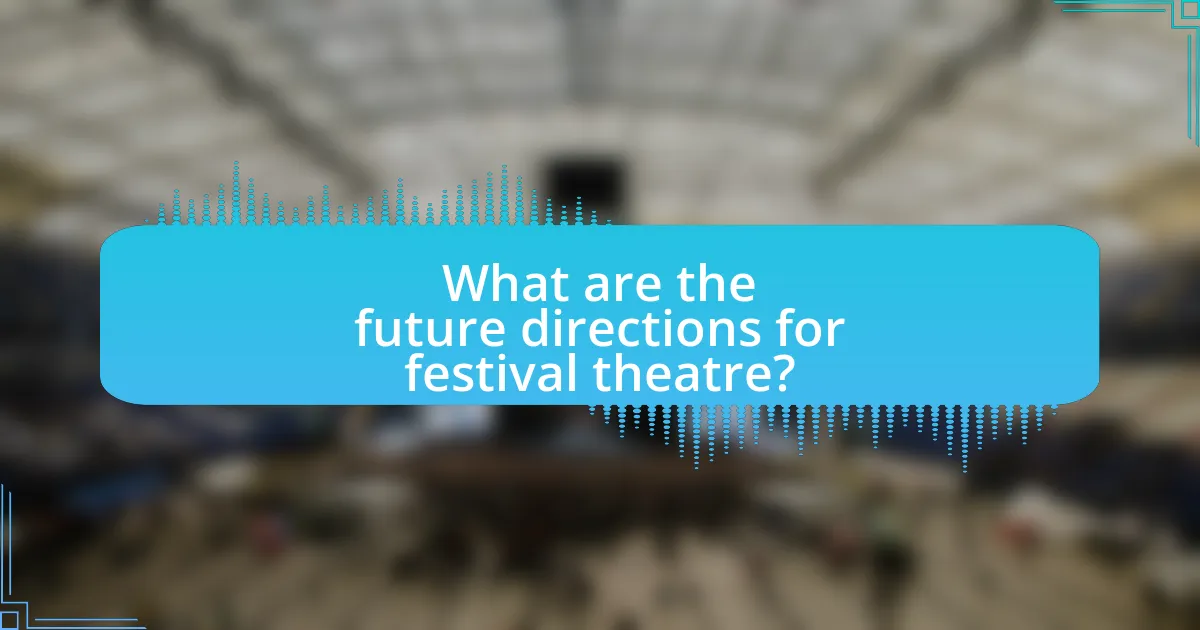
What are the future directions for festival theatre?
Future directions for festival theatre include increased integration of technology, a focus on sustainability, and greater community engagement. The incorporation of virtual and augmented reality is expected to enhance audience experiences, making performances more immersive. Additionally, festivals are increasingly prioritizing eco-friendly practices, such as reducing waste and utilizing renewable resources, reflecting a broader societal shift towards sustainability. Community involvement is also set to grow, with festivals aiming to represent diverse voices and foster local talent, thereby strengthening cultural connections. These trends are supported by industry reports indicating a rising demand for innovative and inclusive theatrical experiences.
How might festival theatre adapt to changing societal needs?
Festival theatre might adapt to changing societal needs by incorporating diverse programming that reflects contemporary social issues and cultural narratives. This adaptation can be seen in the increasing inclusion of marginalized voices and themes, such as racial equality and climate change, which resonate with current societal conversations. For instance, festivals like the Edinburgh Festival Fringe have expanded their offerings to include works that address social justice, thereby attracting a broader audience and fostering community engagement. Additionally, the integration of technology, such as virtual performances and interactive experiences, allows festival theatre to reach audiences who may not be able to attend in person, thus enhancing accessibility and inclusivity.
What potential challenges could festival theatre face in the future?
Festival theatre could face several potential challenges in the future, including financial sustainability, audience engagement, and competition from digital entertainment. Financial sustainability is a significant concern as many festivals rely on ticket sales, sponsorships, and grants, which can fluctuate due to economic conditions. For instance, a report from the National Endowment for the Arts indicates that arts funding can decline during economic downturns, impacting festival budgets.
Audience engagement poses another challenge, as changing demographics and preferences may lead to decreased attendance. According to a study by the Arts Council England, younger audiences are increasingly drawn to digital experiences, which could divert them from traditional festival formats.
Lastly, competition from digital entertainment platforms, such as streaming services, presents a formidable challenge. The rise of on-demand content has shifted audience expectations, making it essential for festival theatre to innovate and offer unique, immersive experiences that cannot be replicated online.
How can festival theatre remain relevant in a digital age?
Festival theatre can remain relevant in a digital age by integrating technology into performances and enhancing audience engagement through digital platforms. By utilizing live streaming, virtual reality, and interactive online experiences, festival theatre can reach broader audiences who may not be able to attend in person. For instance, the National Theatre in the UK has successfully streamed performances to cinemas worldwide, demonstrating that digital access can expand audience reach and maintain interest in live theatre. Additionally, social media can be leveraged for marketing and community building, allowing festivals to connect with younger demographics who are more accustomed to digital interactions. This approach not only preserves the essence of live performance but also adapts to contemporary viewing habits, ensuring festival theatre’s continued relevance.
What best practices can be adopted for the future of festival theatre?
Best practices for the future of festival theatre include embracing sustainability, enhancing community engagement, and leveraging technology. Sustainability can be achieved by implementing eco-friendly practices, such as using renewable energy sources and reducing waste, which aligns with the growing public demand for environmentally responsible events. Community engagement can be fostered through inclusive programming that reflects diverse voices and encourages local participation, thereby strengthening community ties and enhancing audience loyalty. Additionally, leveraging technology, such as virtual reality and live streaming, can expand accessibility and reach wider audiences, as evidenced by the increased online viewership of festivals during the COVID-19 pandemic. These practices not only improve the festival experience but also ensure relevance and resilience in a changing cultural landscape.
How can festival organizers enhance inclusivity and accessibility?
Festival organizers can enhance inclusivity and accessibility by implementing comprehensive planning that addresses diverse needs. This includes providing accessible venues, offering sign language interpretation, and ensuring transportation options are available for individuals with disabilities. According to the Americans with Disabilities Act, public events must accommodate individuals with disabilities, which reinforces the necessity for organizers to prioritize these measures. Additionally, engaging with community groups representing various demographics can help identify specific barriers and solutions, ensuring that festivals are welcoming to all attendees.
What strategies can be implemented to foster innovation in festival theatre?
To foster innovation in festival theatre, implementing collaborative partnerships with diverse artists and organizations is essential. These partnerships can lead to the exchange of ideas and resources, enhancing creativity and broadening the scope of performances. For instance, festivals that collaborate with technology companies have successfully integrated digital elements into their productions, attracting new audiences and creating immersive experiences. Additionally, incorporating audience feedback mechanisms can drive innovation by allowing festival organizers to adapt and evolve based on viewer preferences, as seen in festivals that utilize surveys and interactive platforms to gauge audience engagement.

